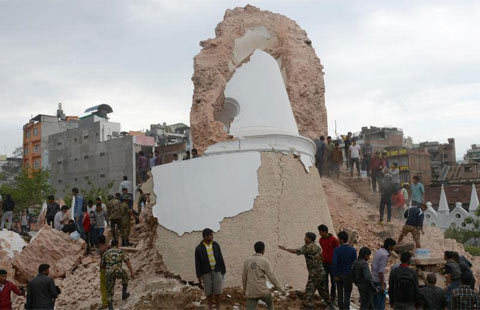City getting green makeover one inch at a time
Updated: 2015-04-03 11:31
By Zhang Kun in Shanghai(China Daily USA)
|
||||||||
 |
|
Any excess electricity generated by the building's solar panels is sold to the local grid and the profits used for green initiatives. |
China is a leading producer of technologies that counter pollution. It is also the world's No 1 producer and user of solar power. Moreover, the country now relies on hundreds of millions of solar-powered water heaters, but this may come as a surprise to many of its 1.4 billion population.
The government recently launched a major push to promote environmental issues. Its next five-year plan, due to be released early next year, is expected to include campaigns to improve the quality of water supplies, air and soil.
"I've lived in Shanghai for 10 years and witnessed Suzhou Creek get much better, mostly because of the government's policy to start to clean up the pollution and water damage," he said.
In his mind, China suffers from negative stereotypes wielded by people outside the country who have scant knowledge of positive developments happening on the ground.
"China is one of the biggest spenders in the world, investing billions and billions of dollars to clean its environment," said Inch. "But it is a big country, so it's taking time."
His books make a point of highlighting green business opportunities for Chinese and people from other countries.
"The most important thing is to start using (these technologies) as they are quite cheap here," he said.
He recalls being impressed during a 2012 trip to Anji, which is promoting itself as an eco-city, by how it had maintained its traditional industries, such as the use of bamboo. His hotel in the green heart of neighboring Zhejiang province surprised him with its forward-thinking innovations.
As he had never encountered such a building in Shanghai, he decided to create one. This was the genesis of LOHAUS.
At first he wanted to take over a used building on the site of the Shanghai 2010 World Expo, an area once rich in pavilions but now full of empty buildings, but only a few were available and the rents were beyond his budget.
Then he stumbled upon the building on Yongjia road about a half-hour trek from his house. It used to house several families before it was converted into a language school and then a shop selling old furniture.
Inch said that in order to keep LOHAUS as widely accessible as possible he tries to see things through a local person's eyes and keep the costs as low as he feasibly can.
zhangkun@chinadaily.com.cn

 International rescue teams head to quake-hit Nepal
International rescue teams head to quake-hit Nepal
 World's deadliest earthquakes since 1900s
World's deadliest earthquakes since 1900s
 Rescuers deliver relief supplies on foot
Rescuers deliver relief supplies on foot
 China brings trapped nationals home from quake-hit Nepal
China brings trapped nationals home from quake-hit Nepal
 Severe drought hits Southwest China
Severe drought hits Southwest China
 History razed in Nepal earthquake
History razed in Nepal earthquake
 'Chi-pao teachers' found in Guangdong
'Chi-pao teachers' found in Guangdong
 Tourists evacuated from Nepal quake area arrive in Kunming
Tourists evacuated from Nepal quake area arrive in Kunming
Most Viewed
Editor's Picks

|

|

|

|

|

|
Today's Top News
Chinese, Koreans seek Japan apology
China rescue team starts work
Three US citizens among dead in avalanche after Nepal quake
Chinese rally across US to support NYC police officer under indictment
New publication will focus on China's energy industry
Abe's US trip: sense or sensibility?
China to overtake US in mobile gaming market
Nearly 2,500 confirmed dead in Nepal quake
US Weekly

|

|






